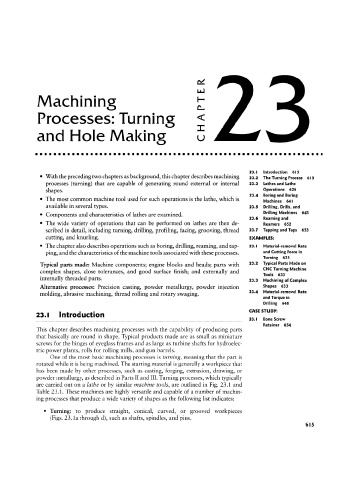Page 634 - 04. Subyek Engineering Materials - Manufacturing, Engineering and Technology SI 6th Edition - Serope Kalpakjian, Stephen Schmid (2009)
P. 634
Machining
Processes: Turning
and Hole Making
23.| Introduction 6l5
° With the preceding two chapters as background, this chapter describes machining 23.2 The Turning Process 6I8
processes (turning) that are capable of generating round external or internal 23.3 Lathes and Lathe
shapes. Operations 626
23.4 Boring and Boring
° The most common machine tool used for such operations is the lathe, which is
Machines 64|
available in several types. 23.5 Drilling, Drills, and
° Components and characteristics of lathes are examined. Drilling Machines 643
23.6 Reaming and
° The wide variety of operations that can be performed on lathes are then de- Reamers 652
scribed in detail, including turning, drilling, profiling, facing, grooving, thread 23.1 Tapping and Taps 653
cutting, and knurling. EXAMPLES:
° The chapter also describes operations such as boring, drilling, reaming, and tap- 23.I Material-removal Rate
ping, and the characteristics ofthe machine tools associated with these processes. and Cutting Force in
Turning 625
Typical parts made: Machine components; engine blocks and heads; parts with 23.2 Typical Parts Made on
CNC Turning Machine
complex shapes, close tolerances, and good surface finish; and externally and
Tools 633
internally threaded parts.
23.3 Machining of Complex
Alternative processes: Precision casting, powder metallurgy, powder injection Shapes 633
molding, abrasive machining, thread rolling and rotary swaging. 23.4 Material-removal Rate
and Torque in
Drilling 648
23.l Introduction CASE STUDY:
23.| Bone Screw
Retainer 654
This chapter describes machining processes with the capability of producing parts
that basically are round in shape. Typical products made are as small as miniature
screws for the hinges of eyeglass frames and as large as turbine shafts for hydroelec-
tric power plants, rolls for rolling mills, and gun barrels.
One of the most basic machining processes is turning, meaning that the part is
rotated while it is being machined. The starting material is generally a workpiece that
has been made by other processes, such as casting, forging, extrusion, drawing, or
powder metallurgy, as described in Parts Il and III. Turning processes, which typically
are carried out on a lathe or by similar mac/vine tools, are outlined in Fig. 23.1 and
Table 23.1. These machines are highly versatile and capable of a number of machin-
ing processes that produce a wide variety of shapes as the following list indicates:
' Turning: to produce straight, conical, curved, or grooved workpieces
(Figs. 23.la through d), such as shafts, spindles, and pins.
'6l5
CHAPTER

